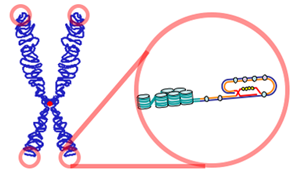Genetic causes of the aging process and death
Aging processes are monitored by the field of gerontology. Knowledge of the changes that accompany old age is important for adequate medical and preventive care for the elderly. Aging processes are individual.
Causes of aging[edit | edit source]
- biological studies of aging are focused on the phenotypic manifestations of cell aging:
- free radical theory – these reactive metabolites react with macromolecules of membranes, cell structures and nucleic acids; they gradually negatively affect their function;
- genetic causes of aging – sought in the accumulation of somatic mutations:
- the functional consequences of gene and chromosomal mutations depend on their location, frequency and type of cell involvement; even non-lethal mutations disrupt the synthesis of proteins important for metabolism and cell renewal;
- mutations can reduce the adaptability of the cell and eventually cause their demise.
Telomeres[edit | edit source]
Molecular genetic findings demonstrate that age is programmed by telomere length. The telomeres of chromosomes are made up of a large number of short repeats that are species-specific. In humans, the repetitive telomere sequence is TTAGGG with a telomere length of 5–15 kb. A telomere is terminated by a single-stranded stretch; the bases of the telomeres are methylated, which allows the formation of a specific hairpin in which the methylated guanosines pair.
The structure of the telomere prevents the cleavage of DNA by deoxyribonucleases, the fusion of DNA molecules in the genome and enables DNA replication without loss of terminal sequences. The complex enzyme telomerase (RNA-dependent DNA polymerase) is capable of lengthening telomeres. It is only active:
- in germline cells,
- bone marrow stem cells,
- stimulated T and B lymphocytes
- and in tumor-transformed cells.
In differentiated somatic cells, telomerase is not expressed and telomere length shortens by about 100 bases with each cell division. Telomere shortening below 2.5 kb is critical for the cell, it stops dividing and apoptosis can be induced in it. Cells with longer telomeres are capable of dividing more than cells with shorter telomeres.
Manifestations of aging[edit | edit source]
Aging is manifested by a decline in the function of individual organ systems. Basal metabolism, pulmonary ventilation and blood flow in individual organs decrease, the performance and ability of the organism to ensure homeostasis of the internal environment is reduced. The performance of the immune system is also of great importance for longevity - it protects the organism not only from infections, but also from neoplasia. Influenceable factors that significantly co-determine life expectancy are the quality of the environment and lifestyle.
Links[edit | edit source]
Related articles[edit | edit source]
- Telomeres and telomerase
- DNA replication
- Replicative aging
- Apoptosis
Sources[edit | edit source]
- ŠTEFÁNEK, Jiří. Medicína, nemoci, studium na 1. LF UK [online]. [cit. 11. 2. 2010]. <https://www.stefajir.cz/>.

